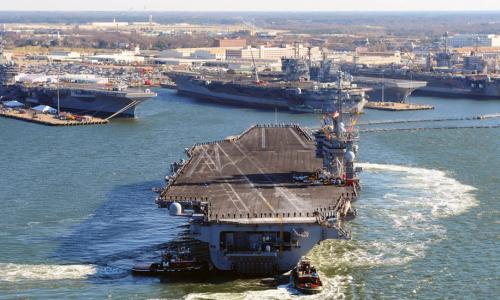Seas are projected to rise between 3.7 and 6.1 feet by the end of this century in the area of Kings Bay.
During the second half of the century, in the absence of preventive measures, Kings Bay and its surrounding areas can expect more frequent and extensive tidal flooding, loss of currently utilized land, and substantial increases in the extent and severity of storm-driven flooding.
Base information
As the home for many of the Navy’s Atlantic-based nuclear-powered submarines, Kings Bay is an important part of the country’s strategic defense system. Additionally, the base’s Trident Training Facility trains sailors to operate submarines, and the Trident Refit Facility maintains and repairs them.
The base is located along the Intracoastal Waterway near the town of St. Marys, Georgia. Roughly one-quarter of the base’s approximately 18,000 acres consist of protected wetlands. The mainland installation is somewhat protected by Cumberland Island, the state’s largest barrier island.
Projected exposure to coastal flooding
The base's exposure to coastal flooding is projected for the years 2050, 2070, and 2100 based on the National Climate Assessment’s midrange or “intermediate-high” sea level rise scenario (referred to here as “intermediate”) and a “highest” scenario based on a more rapid rate of increase.
Tidal flooding, land loss, and storm surge from hurricanes were all modeled. In this analysis, land inundated by at least one high tide each day is considered a loss. This is a conservative metric: in reality, far less frequent flooding would likely lead to land being considered unusable.
The results below outline potential future flooding scenarios for NSB Kings Bay, assuming no new measures are taken to prevent or reduce flooding.
- Certain areas face daily high tide flooding. Today, tidal flooding affects low-lying, mainly wetland areas of NSB Kings Bay, just a couple of times per year on average. This flooding occurs roughly 250 times per year in 2070 in the intermediate scenario and more than 600 times per year in the highest scenario, with flooding occurring during both daily high tides on average.
- Sea level rise threatens certain areas with permanent inundation. With such regular flooding, areas that are currently wetlands would be at risk of shifting to open water, depending on the ecosystem’s ability to keep up with rising seas. Since wetlands typically provide flood protection to inland areas, their health and integrity have bearing on the vulnerability of the installation itself.
- Sea level rise exposes previously unaffected areas of NSB Kings Bay to storm surge flooding. In either the intermediate or the highest scenario, the area exposed to flooding during a Category 1 storm in 2100 is equivalent to the area exposed during a Category 2 storm today. In an end-of-century worst-case scenario involving a Category 4 storm, six feet of sea level rise could expose 20 percent more of the base to storm surge flooding than is exposed today.
- Sea level rise increases the exposure of NSB Kings Bay to deeper, more severe flooding. A Category 4 storm today would expose almost none of the base to 20-foot storm surge depths. With six feet of sea level rise projected in the highest scenario for late this century, a Category 4 storm would flood nearly 95 percent of the base, and more than half of that area would be under 20 feet or more of water.
Preparing for rising seas
The gap between the military’s current preparedness for sea level rise and the threats outlined here is large and growing.
In order to plan effectively for the long term, military decision makers with authority over NSB Kings Bay need to understand how sea level rise may permanently alter the landscape of this coastal installation and where the threat of storm surge may become intolerable.
To take action, however, individual installations like NSB Kings Bay will need more detailed analysis and resources to implement solutions.
Congress and the Department of Defense should, for example, support the development and distribution of high-resolution hurricane and coastal flooding models; adequately fund data monitoring systems such as our nation’s tide gauge network; allocate human, financial, and data resources to detailed mapping and planning efforts at military installations; and, as adaptive measures are identified, allocate resources for these projects, many of which will stretch over decades.
Our defense leadership has a special responsibility to protect the sites that hundreds of thousands of Americans depend on for their livelihoods and millions depend on for national security.
Additional maps and resources
This analysis modeled exposure to coastal flooding for four different points in time (2012, 2050, 2070, and 2100) and two different sea level rise scenarios.
For each time horizon and scenario, we analyzed storm surge from Category 1 through 5 hurricanes, the extent and frequency of flooding from extra-high tides, and inundation from ordinary high tides.
Detailed maps for each scenario at NSB Kings Bay are available via Dropbox.
For more, please see the methodology used for this analysis.




